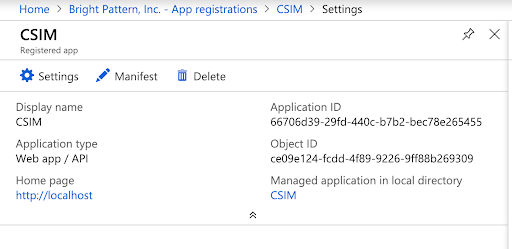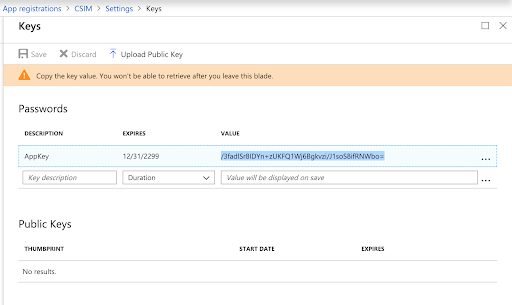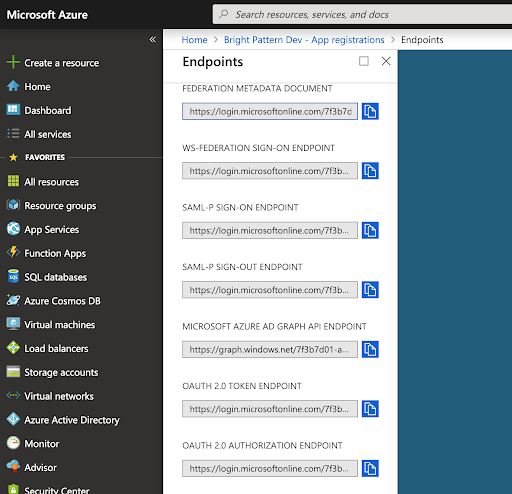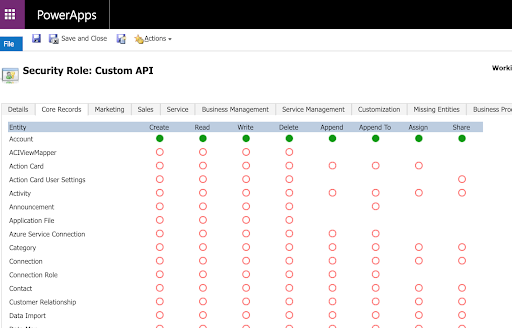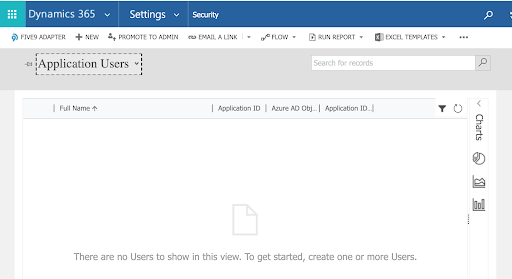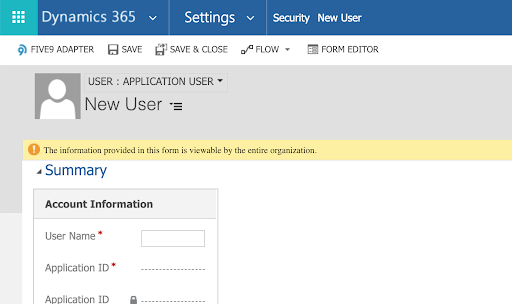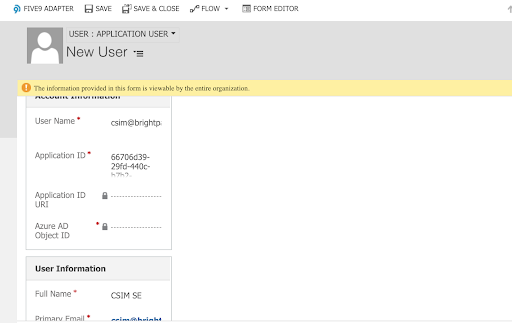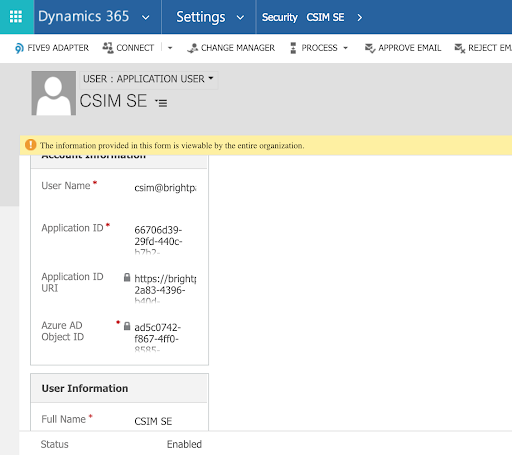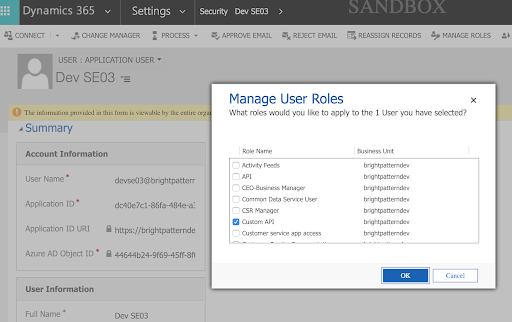From Bright Pattern Documentation
| Line 12: | Line 12: | ||
== Step 2: Add API access == | == Step 2: Add API access == | ||
| − | # In the newly created app, go to ''Required Permissions | + | # In the newly created app, go to '' Settings > API Access > Required Permissions'' and click '''Add''' to add API access.<br /><br>[[File:MS365-12-53.png|800px|thumbnail|center|Add API access]]<br /><br> |
# In ''Add API access'', make the following selections:<br /><br> | # In ''Add API access'', make the following selections:<br /><br> | ||
| − | ## In ''Select an API'', select '''Dynamics CRM Online | + | ## In ''Select an API'', select '''Dynamics CRM Online'''.<br /><br> |
## Select the checkbox for '''Delegated Permissions'''.<br /><br> | ## Select the checkbox for '''Delegated Permissions'''.<br /><br> | ||
| − | ## When done, click '''Grant Permissions'''.<br /><br> | + | ## When done, click '''Grant Permissions''' and click '''Yes'''.<br /><br> |
== Step 3: Get the key (the Client Secret) and endpoint == | == Step 3: Get the key (the Client Secret) and endpoint == | ||
| − | # In the newly created app, go to ''Keys'' and:<br /><br> | + | # In the newly created app, go to ''Settings > API Access > Keys'' and:<br /><br> |
## In ''Description'', name the app key.<br /><br> | ## In ''Description'', name the app key.<br /><br> | ||
## In ''Expires'', set '''Never expires'''.<br /><br> | ## In ''Expires'', set '''Never expires'''.<br /><br> | ||
## Click '''Save'''. Once saved, the key value will be shown. The key value is the ''Client Secret'', which you need for later configuration steps.<br /><br> | ## Click '''Save'''. Once saved, the key value will be shown. The key value is the ''Client Secret'', which you need for later configuration steps.<br /><br> | ||
## '''Copy the key value now''' because this is the only moment you can see the actual key.<br /><br>[[File:MS365-13-53.png|800px|thumbnail|center|The key is the Client Secret]]<br /><br> | ## '''Copy the key value now''' because this is the only moment you can see the actual key.<br /><br>[[File:MS365-13-53.png|800px|thumbnail|center|The key is the Client Secret]]<br /><br> | ||
| − | # Go to ''App Registrations | + | # Go back to ''Azure Active Directory > App Registrations'' and click '''Endpoints'''.<br /><br /> |
| + | # Copy the '''OAUTH 2.0 Authorization Endpoint''' and '''OAUTH 2.0 Token Endpoint''' values.<br /><br>[[File:MS365-14-53.png|800px|thumbnail|center|OAUTH 2.0 endpoint values]]<br /><br> | ||
== Step 4: Update security roles == | == Step 4: Update security roles == | ||
Revision as of 00:19, 4 April 2019
<translate>
Configure Microsoft Azure and Dynamics 365 CRM for Web API access
Step 1: Add new registered app
- In the Azure Portal > Azure Active Directory > App Registrations, click + New registration to add a new registered app.
- View the registered app and click Settings.
- Then click Properties, and edit the properties with the following values:
- Application type - Web app / API
- Application ID - The Client ID
- Object ID - This ID will be filled in for the registered app
- Home page - http://localhost [Note: use exactly this value as it also will be hardcoded in the Azure Portal]
- Application type - Web app / API
Step 2: Add API access
- In the newly created app, go to Settings > API Access > Required Permissions and click Add to add API access.
- In Add API access, make the following selections:
- In Select an API, select Dynamics CRM Online.
- Select the checkbox for Delegated Permissions.
- When done, click Grant Permissions and click Yes.
- In Select an API, select Dynamics CRM Online.
Step 3: Get the key (the Client Secret) and endpoint
- In the newly created app, go to Settings > API Access > Keys and:
- In Description, name the app key.
- In Expires, set Never expires.
- Click Save. Once saved, the key value will be shown. The key value is the Client Secret, which you need for later configuration steps.
- Copy the key value now because this is the only moment you can see the actual key.
- In Description, name the app key.
- Go back to Azure Active Directory > App Registrations and click Endpoints.
- Copy the OAUTH 2.0 Authorization Endpoint and OAUTH 2.0 Token Endpoint values.
Step 4: Update security roles
- Open the Dynamics 365 CRM (not Azure) application, and go to Settings > Security > Security Roles.
- Add new role (or copy existing role).
- Make sure the role has required privileges (the screenshot shown only grants access to the Account CRM object).
- Add new role (or copy existing role).
Step 5: Add app users
- Go to Settings > Security > Users.
- Switch view to Application Users.
- Switch view to Application Users.
- Add new user.
- Once new user form is shown, change it to Application User.
- Once new user form is shown, change it to Application User.
- In Account Information, fill in the following:
- User Name
- Application ID - Your application ID (i.e., the Client ID)
- User Name
- In User Information, fill in the following:
- Full Name - User's first name and last name
- Primary Email - User's email address
- Full Name - User's first name and last name
- Save the record. At this time, the Application ID URI and Azure AD Object ID fields are filled in.
Step 6: Add roles to the users you created
- Click Manage Roles.
- In Manage User Roles, add the custom role created to that user.
- In Manage User Roles, add the custom role created to that user.
This completes Microsoft Dynamics 365 CRM and Azure configuration.
</translate>

